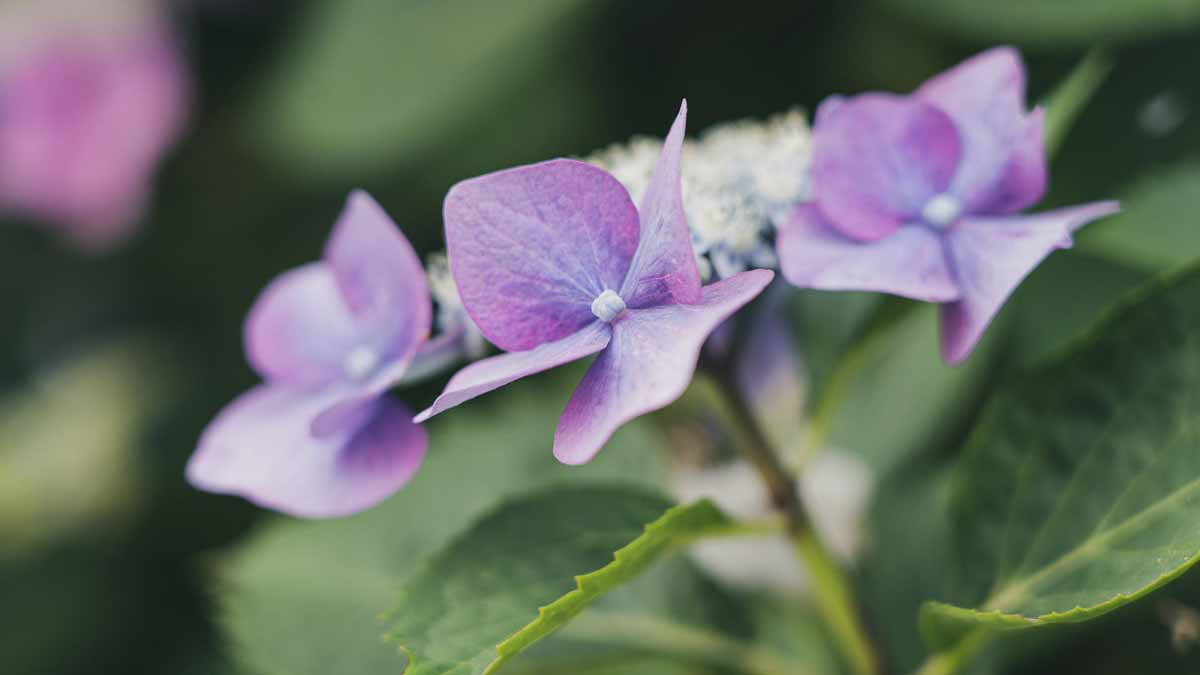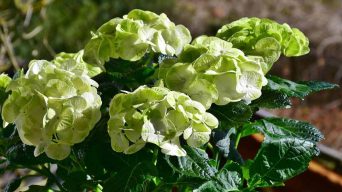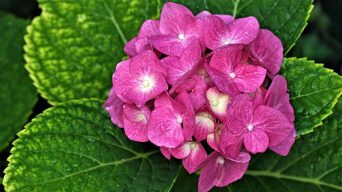Hydrangea plants are known for their large, showy flowers, which make them popular garden plants.
However, hydrangeas sometimes become leggy and overgrown, with bare stems and few leaves.
If your Hydrangea is looking a bit leggy, don’t worry – there are some simple steps you can take to fix it.
Here you will find everything you need to know about fixing a leggy hydrangea, including causes and solutions.
What Causes Hydrangeas To Become Leggy
There are a few different reasons why hydrangeas can become leggy.
One common cause is the lack of sunlight.
Hydrangeas need at least 6 hours of sunlight per day to thrive.
If they don’t get enough sun, they will start to stretch out and become leggy in search of light.
Hydrangea plants thrive in partial sun or dappled sunlight.
Morning sun followed by afternoon shade is ideal. This will help prevent the flowers from wilting in the day’s heat.
They can also tolerate some shade, but too much shade will cause them to become leggy.
Another common cause of leggy hydrangeas is too much fertilizer.
Hydrangeas are sensitive to fertilizer, and too much can cause them to produce more leaves and stems than flowers.
High nitrogen fertilizer is particularly likely to cause leggy growth.
How To Tell If Your Hydrangea Is Leggy
There are a few signs that will help you to tell if your Hydrangea is leggy.
The most common signs are:
Bare Stems With Few Leaves
If you see mostly bare stems with very few leaves, especially at the bottom of the plant, your Hydrangea is probably leggy.
This is usually caused by insufficient sunlight reaching the plant’s lower parts.
To check if this is the case, try moving your plant to a sunnier spot and see if it makes a difference.
Stems That Are Long and Spindly
If the stems of your plant are long and spindly, it’s another sign that your Hydrangea is leggy.
When the plant doesn’t get enough sunlight, it will try to grow towards the light, resulting in long and spindly stems.
Stretching Towards the Light
If you see your Hydrangea stretching towards the light, it is probably leggy. This is because the plant is not getting enough light and is trying to reach for it.
When a plant stretches, it becomes weaker and more vulnerable to breakage.
If you see your Hydrangea stretching, try moving it to a sunnier spot.
The Leaves Are Clustered at the Top
If the leaves of your plant are clustered at the top, it is another sign that your Hydrangea is leggy.
This happens because the plant is not getting enough light, and the leaves are trying to reach for the light.
The Flowers Are Sparse
If your plant has sparse and not very full flowers, it is probably leggy.
This is because the plant is not getting enough light, and the flowers cannot bloom properly.
The light is essential for the flowers to bloom properly.
The Plant Looks Weak and Unhealthy
If your plant looks weak and unhealthy, it is probably leggy. This is because the plant is not getting enough light and cannot grow properly.
The Hydrangea leaves might be yellow or pale, and the stems might be thin and spindly.
How To Fix a Leggy Hydrangea
If your Hydrangea is looking a bit leggy, there are some simple steps you can take to fix it.
Here are some of the best ways to fix a leggy hydrangea:
Move Your Plant to a Sunnier Spot
If your Hydrangea is not getting enough sunlight, try moving it to a sunnier spot.
Hydrangeas need at least 6 hours of sunlight per day to thrive.
So, if possible, try to move your plant to a place where it will get morning sun followed by afternoon shade.
This will help to prevent the flowers from wilting in the heat of the day.
Indoor hydrangea plants can be placed near a bright window. A south-facing window is best, but a north-facing window will also work.
If you can’t move your plant to a sunnier spot, you can try increasing the amount of light it gets with artificial lighting.
You can do this by placing grow lights near your plant.
Outdoor hydrangeas can also be placed under trees or other structures that will provide some protection from the hot afternoon sun.
An area that gets dappled sunlight throughout the day is ideal.
Prune Your Plant
Pruning your plant is one of the best ways to fix a leggy hydrangea.
It will help to encourage new growth and make your plant look fuller and more compact.
To prune your plant, start by removing any dead or diseased stems.
Then, cut back the remaining stems by one-third to one-half their length.
It’s best to prune your plant in late winter or early spring before new growth begins.
This will give the plant time to recover from the pruning and produce new growth for the upcoming season.
Stop Fertilizing Your Plant
If you’re fertilizing your plant too much, it can cause the stems to become long and spindly.
It’s best to stop fertilizing your plant altogether or only fertilize it once a year in late winter or early spring.
This will help to prevent the plant from becoming leggy.
When you fertilize your plant, use a balanced fertilizer low in nitrogen.
Too much nitrogen will cause the plant to produce too much growth, making it leggy.
How to Prune Leggy Hydrangeas (A Step-By-Step Guide)
Pruning is essential to keeping your hydrangeas healthy and looking their best.
While it may seem daunting, it’s pretty simple once you know how.
Here’s a step-by-step guide on how to prune leggy hydrangeas:
- Removing any dead or damaged wood. Cut these branches to just above where they meet a healthy branch.
- Cut back any branches that are growing out of bounds. These can be cut back to the desired length or shape.
- Thin out the plant by removing some of the older stems near the base of the plant. This will encourage new growth and help keep the plant from becoming too dense.
- Cut back the remaining stems by one-third to one-half their length. This will encourage bushier growth and more flowers.
- Prune your hydrangeas in late winter or early spring before new growth begins. This will give them the best chance to recover and bloom profusely.
With these simple tips, you’ll have your leggy hydrangeas looking neat and tidy in no time!
How Do You Keep Hydrangeas From Getting Leggy?
There are a few things you can do to prevent your hydrangeas from getting leggy in the first place:
1. Place Them in an Area With Full Sun To Partial Shade
Hydrangeas need at least six hours of sunlight per day to thrive.
If they don’t get enough sun, they will become leggy and stretch out to try and reach the light. The best place to put them is in an area with morning full sun followed by partial afternoon shade.
Ensure your plant is protected from the hot afternoon sun to prevent the flowers from wilting.
Place your Hydrangea near a sunny window but out of direct sunlight when grown indoors.
Outdoor hydrangeas can be placed in a shady spot during the hottest part of the day.
2. Turn Them Every Few Weeks
When you first get your Hydrangea, place it where you want it to grow. Then, every few weeks, turn the pot 180 degrees so that the plant receives evenly lit on all sides.
If you don’t turn the plant, it will grow towards the light, causing it to become leggy.
3. Prune Them Regularly
Hydrangeas need to be pruned regularly to prevent them from becoming leggy. The best time to prune them is in late winter or early spring before new growth begins.
To prune your Hydrangea, cut back all the stems by about one-third. Cut them back to where they branch off from the main stem. This will encourage new growth and prevent the plant from becoming leggy.
4. Don’t Overfertilize Them
Fertilizing your Hydrangea is essential, but you must be careful not to overfertilize it. Overfertilizing can cause the plant to produce too much growth, leading to leggy stems.
High nitrogen fertilizer will cause the plant to produce more leaves and fewer flowers. Use a low-nitrogen fertilizer or one specifically for hydrangeas instead.
Fertilize your Hydrangea during the growing season, from spring to fall. Stop fertilizing in late fall so that the plant can go into dormancy for the winter.
Final Thoughts
Even if your Hydrangea looks a bit leggy, there’s no need to despair.
You can bring it back to its former glory with a bit of patience and proper care.
Here are the key takeaways from this article:
- If your Hydrangea looks leggy, it’s probably because it’s not getting enough sunlight. Make sure to place it where it will get at least six hours of sunlight daily.
- If your Hydrangea is leggy, it’s also likely that it’s overfertilized. Stop fertilizing it and use a diluted solution of half-strength fertilizer once every two weeks.
- Prune your Hydrangea regularly to encourage new growth and prevent legginess.
With these tips in mind, you should have no problem getting your leggy Hydrangea back on track.







